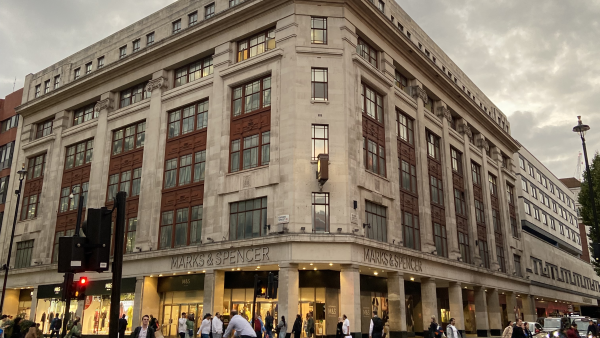To retrofit or not to retrofit: what’s going on with Marks & Spencer’s Oxford Street store?
Posted on: 29 May, 2024

Marks and Spencer have been embroiled in a dispute with the government that has raised questions around sustainability and the built environment. Here’s what’s happened.
On Oxford Street in London, the future of a clothing brand’s flagship store has spiralled into a heated debate about the future of the built environment.
This March, Secretary of State for Levelling Up Michael Gove’s rejection of retail giant Marks & Spencer’s proposed demolition of their Marble Arch store was overturned after the brand launched legal action. This was the latest twist in a protracted conflict that has lasted three years, and prompted questions around the fate of ageing buildings and the impact of new sustainability policies on future developments.
In this article, we’ll dive into the history of the Marble Arch project and explore the environmental concerns that have been raised from both sides of the debate.
What’s the story behind the Marble Arch plans?
M&S have occupied the Marble Arch store in Oxford Street since the 1930s, shortly after its construction. In 2021, the brand released a statement revealing their plans to demolish and rebuild the site into a new mixed-use retail and office complex.
Learn more: Are mixed-use developments the future of construction?
From the outset, the project was met with criticism. British charity SAVE Britain’s Heritage and the Architects Journal campaign RetroFirst were among the key drivers of the protests against M&S, claiming that the demolition project would release as much as 40,000 tonnes of carbon dioxide into the atmosphere – the equivalent of almost 20,000 London to Sydney flights. In a report published in January 2022, a critical report by zero carbon expert Simon Sturgis was released which claimed the Marble Arch plans ‘were directly at odds with government policy’.
Despite concerns, the plans were approved by both the Westminster council and the Mayor of London, Sadiq Khan, in April 2022. However, a public inquiry proposed by Michael Gove was launched later in October, and by July of 2023, the plans were rejected by the government. This news came as a relief to many environmental campaigners, after two years of protests and petitions against the project.
Unsurprisingly, M&S were unhappy with the move. Stuart Machin, CEO of M&S, claimed that retrofitting the building ‘was not an option – despite us reviewing sixteen different options’. He dubbed the decision to be ‘pathetic’, ‘anti-business’ and ‘the whim of one man’. They also went on to argue that, despite the arguments for the site’s heritage, it had twice been denied listed status.
Yet while it was seen as a win at the time for environmental campaigners that signalled a shift towards a policy of retrofitting, the move by the government wasn’t without criticism. Many believed the decision to block the project was a symbolic act to mark a change in governmental policy that hadn’t actually happened yet. As such, M&S identified 17 other, similar demolition projects which had been approved in Westminster.
Learn more: What does the UK general election mean for the built environment?
What’s the latest?
M&S responded by launching a legal challenge and ‘reviewing their future position’ on Oxford Street, taking the government to court and winning. In court, Mrs Justice Nathalie Lieven ruled that Gove had effectively “rewritten” planning policy in his decision.
As M&S Operations Director Sacha Berendji commented:
“The result has been a long, unnecessary and costly delay to the only retail-led generation on Oxford Street which would deliver one of London’s greenest buildings, create thousands of new jobs and rejuvenate the capital’s premier shopping district.”
The debate around retrofitting
At the heart of the controversy surrounding the Marble Arch project is the question of retrofitting.
Updating old buildings through activities like retrofitting and adaptive reuse have emerged as a popular alternative to demolition amid concerns around sustainability. Retrofitting activities like installing electric heat pumps can reduce the energy demand in properties by as much as 50%.
Many of the protests around the proposed Marble Arch project questioned why the brand hadn’t pursued a retrofitting project. As Henrietta Billings, Director of SAVE Britain’s Heritage, commented:
“There’s no need to demolish this historic M&S building. Through our campaign, we’ve shown that with a comprehensive retrofit, this building can continue to serve as a landmark on Oxford Street for the next 100 years.”
Will Hurst, Managing Editor the Architects Journal, added:
“To combat global warming, we urgently need to halt unnecessary demolition and revitalise buildings instead.”
Learn more: Breaking the path to appropriate, sustainable interventions
Had M&S considered retrofitting and refurbishment?
M&S acknowledged that they expected criticism for the project in their initial statement three years ago. They claimed to ‘have been looking very closely at options for refurbishing the store’, but that it ‘quickly became clear that redevelopment was the only viable way forward to re-imagine a store that will be fit for purpose and fit for the future’.
The high street brand also stated that the new project ‘offered significant sustainability advantages over a refurbishment because over the long term, the modern lower-carbon building will more than offset any emissions from the redevelopment’. They also claimed that the building ‘would be among London’s most sustainable’ and would pay back the construction emissions in 11 years. However, campaigners claimed that the brand hadn’t considered a deep retrofit.
Learn more: A guide to retrofitting (and how it could help us reach net zero)
What’s next?
While it looks like the demolition may now go ahead after M&S won their court challenge against Gove, there’s every chance that we haven’t seen the end of this debate. For now, it’s come to represent an important shift in sustainable policy, the future of the built environment, and the challenge of balancing the modernisation of infrastructure with the preservation of heritage.
What are your thoughts on the Marble Arch project? Get in touch with us at press@ucem.ac.uk.





